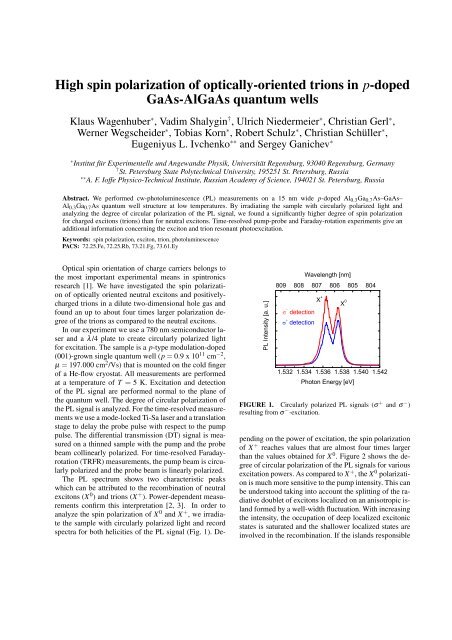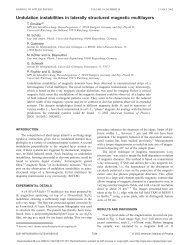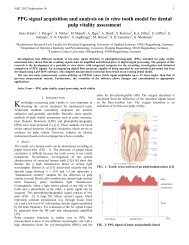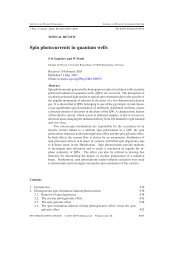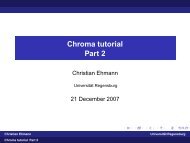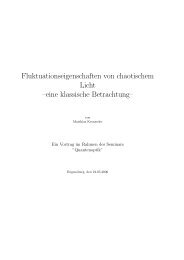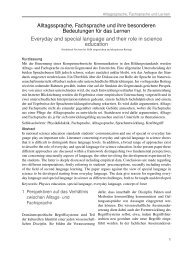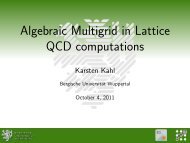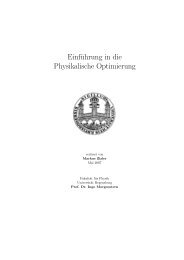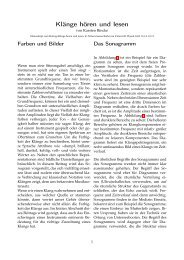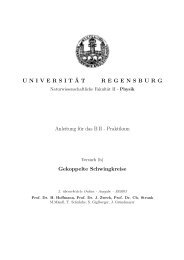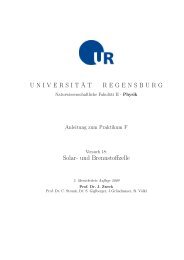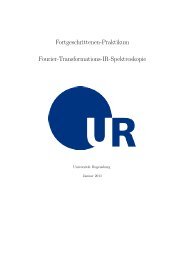High spin polarization of optically-oriented trions in p-doped GaAs ...
High spin polarization of optically-oriented trions in p-doped GaAs ...
High spin polarization of optically-oriented trions in p-doped GaAs ...
You also want an ePaper? Increase the reach of your titles
YUMPU automatically turns print PDFs into web optimized ePapers that Google loves.
<strong>High</strong> <strong>sp<strong>in</strong></strong> <strong>polarization</strong> <strong>of</strong> <strong>optically</strong>-<strong>oriented</strong> <strong>trions</strong> <strong>in</strong> p-<strong>doped</strong><br />
<strong>GaAs</strong>-Al<strong>GaAs</strong> quantum wells<br />
Klaus Wagenhuber ∗ , Vadim Shalyg<strong>in</strong> † , Ulrich Niedermeier ∗ , Christian Gerl ∗ ,<br />
Werner Wegscheider ∗ , Tobias Korn ∗ , Robert Schulz ∗ , Christian Schüller ∗ ,<br />
Eugeniyus L. Ivchenko ∗∗ and Sergey Ganichev ∗<br />
∗ Institut für Experimentelle und Angewandte Physik, Universität Regensburg, 93040 Regensburg, Germany<br />
† St. Petersburg State Polytechnical University, 195251 St. Petersburg, Russia<br />
∗∗ A. F. I<strong>of</strong>fe Physico-Technical Institute, Russian Academy <strong>of</strong> Science, 194021 St. Petersburg, Russia<br />
Abstract. We performed cw-photolum<strong>in</strong>escence (PL) measurements on a 15 nm wide p-<strong>doped</strong> Al0.3Ga0.7As–<strong>GaAs</strong>–<br />
Al0.3Ga0.7As quantum well structure at low temperatures. By irradiat<strong>in</strong>g the sample with circularly polarized light and<br />
analyz<strong>in</strong>g the degree <strong>of</strong> circular <strong>polarization</strong> <strong>of</strong> the PL signal, we found a significantly higher degree <strong>of</strong> <strong>sp<strong>in</strong></strong> <strong>polarization</strong><br />
for charged excitons (<strong>trions</strong>) than for neutral excitons. Time-resolved pump-probe and Faraday-rotation experiments give an<br />
additional <strong>in</strong>formation concern<strong>in</strong>g the exciton and trion resonant photoexcitation.<br />
Keywords: <strong>sp<strong>in</strong></strong> <strong>polarization</strong>, exciton, trion, photolum<strong>in</strong>escence<br />
PACS: 72.25.Fe, 72.25.Rb, 73.21.Fg, 73.61.Ey<br />
Optical <strong>sp<strong>in</strong></strong> orientation <strong>of</strong> charge carriers belongs to<br />
the most important experimental means <strong>in</strong> <strong>sp<strong>in</strong></strong>tronics<br />
research [1]. We have <strong>in</strong>vestigated the <strong>sp<strong>in</strong></strong> <strong>polarization</strong><br />
<strong>of</strong> <strong>optically</strong> <strong>oriented</strong> neutral excitons and positivelycharged<br />
<strong>trions</strong> <strong>in</strong> a dilute two-dimensional hole gas and<br />
found an up to about four times larger <strong>polarization</strong> degree<br />
<strong>of</strong> the <strong>trions</strong> as compared to the neutral excitons.<br />
In our experiment we use a 780 nm semiconductor laser<br />
and a λ/4 plate to create circularly polarized light<br />
for excitation. The sample is a p-type modulation-<strong>doped</strong><br />
(001)-grown s<strong>in</strong>gle quantum well (p = 0.9 x 10 11 cm −2 ,<br />
µ = 197.000 cm 2 /Vs) that is mounted on the cold f<strong>in</strong>ger<br />
<strong>of</strong> a He-flow cryostat. All measurements are performed<br />
at a temperature <strong>of</strong> T = 5 K. Excitation and detection<br />
<strong>of</strong> the PL signal are performed normal to the plane <strong>of</strong><br />
the quantum well. The degree <strong>of</strong> circular <strong>polarization</strong> <strong>of</strong><br />
the PL signal is analyzed. For the time-resolved measurements<br />
we use a mode-locked Ti-Sa laser and a translation<br />
stage to delay the probe pulse with respect to the pump<br />
pulse. The differential transmission (DT) signal is measured<br />
on a th<strong>in</strong>ned sample with the pump and the probe<br />
beam coll<strong>in</strong>early polarized. For time-resolved Faradayrotation<br />
(TRFR) measurements, the pump beam is circularly<br />
polarized and the probe beam is l<strong>in</strong>early polarized.<br />
The PL spectrum shows two characteristic peaks<br />
which can be attributed to the recomb<strong>in</strong>ation <strong>of</strong> neutral<br />
excitons (X 0 ) and <strong>trions</strong> (X + ). Power-dependent measurements<br />
confirm this <strong>in</strong>terpretation [2, 3]. In order to<br />
analyze the <strong>sp<strong>in</strong></strong> <strong>polarization</strong> <strong>of</strong> X 0 and X + , we irradiate<br />
the sample with circularly polarized light and record<br />
spectra for both helicities <strong>of</strong> the PL signal (Fig. 1). De-<br />
<br />
<br />
<br />
<br />
<br />
<br />
<br />
<br />
<br />
<br />
FIGURE 1. Circularly polarized PL signals (σ + and σ − )<br />
result<strong>in</strong>g from σ − -excitation.<br />
pend<strong>in</strong>g on the power <strong>of</strong> excitation, the <strong>sp<strong>in</strong></strong> <strong>polarization</strong><br />
<strong>of</strong> X + reaches values that are almost four times larger<br />
than the values obta<strong>in</strong>ed for X 0 . Figure 2 shows the degree<br />
<strong>of</strong> circular <strong>polarization</strong> <strong>of</strong> the PL signals for various<br />
excitation powers. As compared to X + , the X 0 <strong>polarization</strong><br />
is much more sensitive to the pump <strong>in</strong>tensity. This can<br />
be understood tak<strong>in</strong>g <strong>in</strong>to account the splitt<strong>in</strong>g <strong>of</strong> the radiative<br />
doublet <strong>of</strong> excitons localized on an anisotropic island<br />
formed by a well-width fluctuation. With <strong>in</strong>creas<strong>in</strong>g<br />
the <strong>in</strong>tensity, the occupation <strong>of</strong> deep localized excitonic<br />
states is saturated and the shallower localized states are<br />
<strong>in</strong>volved <strong>in</strong> the recomb<strong>in</strong>ation. If the islands responsible
FIGURE 2. Circular <strong>polarization</strong> degree <strong>of</strong> PL signals from<br />
neutral and charged exciton recomb<strong>in</strong>ation <strong>in</strong> an excitation<br />
density range where both peaks are present <strong>in</strong> the PL spectrum.<br />
For excitation circularly polarized light with λ = 780 nm was<br />
used.<br />
for the shallower states are more anisotropic, the <strong>sp<strong>in</strong></strong> decoherence<br />
aris<strong>in</strong>g because <strong>of</strong> the anisotropic splitt<strong>in</strong>g is<br />
enhanced, result<strong>in</strong>g <strong>in</strong> the lower PL <strong>polarization</strong>.<br />
The DT experiment ma<strong>in</strong>ly probes the transient<br />
bleach<strong>in</strong>g <strong>of</strong> the optical absorption due to the creation <strong>of</strong><br />
photocarriers. In our experiments we used 100 fs pulses<br />
with an energetic FWHM <strong>of</strong> about 20 meV, which were<br />
centered at an energy <strong>of</strong> 1.535 eV. Compar<strong>in</strong>g this to the<br />
PL spectra <strong>in</strong> Fig. 1, it is obvious that we excite simultaneously<br />
X + and X 0 . In the DT experiment we observe<br />
two processes (see Fig. 3). On the ultrafast timescale,<br />
we f<strong>in</strong>d that a very small part <strong>of</strong> the DT signal decays<br />
with<strong>in</strong> the first few picoseconds, as seen <strong>in</strong> Fig. 3b. On<br />
the slower timescale, we f<strong>in</strong>d a monoexponential decay<br />
with a time constant <strong>of</strong> about 890 ps, shown <strong>in</strong> Fig. 3a.<br />
The ultrafast decay can be attributed to the recomb<strong>in</strong>ation<br />
<strong>of</strong> excitons, which are directly generated <strong>in</strong>to<br />
the narrow center-<strong>of</strong>-mass momentum cone <strong>of</strong> radiative<br />
states or to free <strong>trions</strong> generated by the pulse [3]. With<br />
the measurements done so far, we can not discrim<strong>in</strong>ate<br />
between these two processes. This would be possible<br />
by selective resonant excitation <strong>of</strong> either the X + or the<br />
X 0 with energetically narrower pulses, which is planned<br />
for the near future. The slow decay <strong>in</strong> Fig. 3a can be<br />
related to hot excitons, which occupy the states outside<br />
the above cone and are occasionally scattered <strong>in</strong>to the<br />
cone or to a system <strong>of</strong> localized excitons and <strong>trions</strong>. The<br />
monoexponential character <strong>of</strong> the decay evidences the<br />
hot-exciton mechanism <strong>of</strong> the pump-probe response with<br />
negligible contribution from trion states. This suggests<br />
for exciton resonant photoexcitation <strong>in</strong>direct optical<br />
transitions assisted by resident heavy holes, which can<br />
carry an excess momentum.<br />
The TRFR measurement probes the <strong>sp<strong>in</strong></strong> relaxation time<br />
<strong>of</strong> the photogenerated carriers. In our measurement<br />
<br />
<br />
<br />
<br />
<br />
<br />
<br />
<br />
<br />
<br />
<br />
<br />
<br />
<br />
<br />
<br />
<br />
<br />
FIGURE 3. (a) Differential transmission over a broad time<br />
range. The <strong>in</strong>set (b) shows a measurement around ∆t = 0 with<br />
high temporal resolution. (c) Time resolved Faraday rotation.<br />
we observe a biexponential decay <strong>of</strong> the TRFR signal,<br />
with decay constants t1 = 10 ps and t2 = 81 ps, as deduced<br />
from Fig. 3c, which can be attributed to <strong>sp<strong>in</strong></strong> relaxation<br />
times <strong>of</strong> holes and electrons, respectively. These<br />
f<strong>in</strong>d<strong>in</strong>gs need an additional analysis, <strong>in</strong> particular regard<strong>in</strong>g<br />
selective excitation <strong>of</strong> X 0 and X + .<br />
In summary, PL measurements show a significantly<br />
higher degree <strong>of</strong> <strong>sp<strong>in</strong></strong> <strong>polarization</strong> for <strong>trions</strong> than for neutral<br />
excitons. Time-resolved experiments <strong>in</strong>dicate that for<br />
the neutral excitons, the photocarrier lifetime <strong>of</strong> hot excitons<br />
is longer than the <strong>sp<strong>in</strong></strong> relaxation time <strong>of</strong> the electrons.<br />
As a consequence, the majority <strong>of</strong> the neutral excitons<br />
loses its <strong>sp<strong>in</strong></strong> orientation dur<strong>in</strong>g thermalization, before<br />
recomb<strong>in</strong>ation. For the stronger <strong>polarization</strong> <strong>of</strong> the<br />
<strong>trions</strong>, two contributions may exist, which needs further<br />
<strong>in</strong>vestigation: Provided that the <strong>trions</strong> have a much shorter<br />
carrier lifetime than the neutral excitons, a larger part<br />
<strong>of</strong> them would decay radiatively before <strong>sp<strong>in</strong></strong> coherence<br />
is lost. In addition, the <strong>sp<strong>in</strong></strong> <strong>polarization</strong> <strong>of</strong> <strong>trions</strong> can be<br />
expected to be more stable because the two holes <strong>in</strong> the<br />
trion complex form the s<strong>in</strong>glet <strong>sp<strong>in</strong></strong> state and the electronhole<br />
exchange is switched <strong>of</strong>f and gives rise to no <strong>sp<strong>in</strong></strong><br />
decoherence <strong>of</strong> the unpaired electron.<br />
We acknowledge support by the Deutsche Forschungsgeme<strong>in</strong>schaft<br />
via SFB 689, GK 638 and project<br />
Schu1171/1.<br />
REFERENCES<br />
1. E.L. Ivchenko, Optical Spectroscopy <strong>of</strong> Semiconductor<br />
Nanostructures (Alpha Science, Harrow, 2005).<br />
2. Gleb F<strong>in</strong>kelste<strong>in</strong>, Hadas Shtrikman, and Israel Bar-Joseph ,<br />
Phys. Rev. B 53,R1709 (1995).<br />
3. D. Sanvitto, R. A. Hogg, A. J. Shields, D. M. Whittaker,<br />
M. Y. Simmons, D. A. Ritchie, and M. Pepper, Phys. Rev.<br />
B 62, R13 294 (2000).


